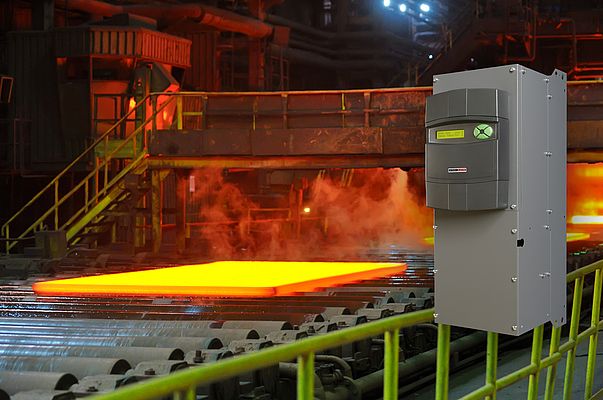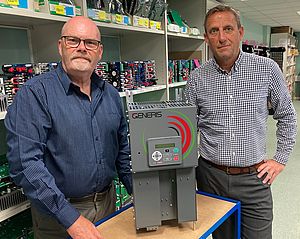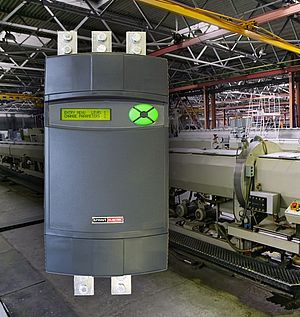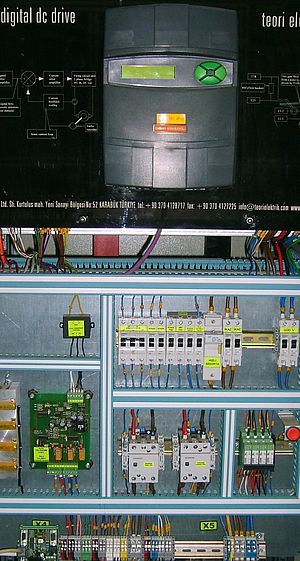"The ability of DC drives to regenerate energy under braking without the need for complex intermediate storage or power bridges is just one of the benefits of DC technology", says Gary Keen, sales director at Sprint Electric.
With its recently extended PLX range, Sprint Electric offers the latest in three phase digital DC drive technology. "The demise of DC variable speed drives has been predicted by many people for years, but the inherent advantages of DC current for applications requiring accurate control of motor speed and torque, especially at low or zero speeds, mean this technology is still very much alive", explains Gary Keen. "Today's modern digital DC drives have benefited from considerable investment from DC specialists like Sprint Electric, and are equal to or better than AC drives in terms of ease of use, simple programming and reliability."
And, despite the undoubted improvements in AC sensorless vector drives, there are several key areas in which DC outperforms AC for the majority of industrial applications such as hoists, extruders, paper machines, wire drawing and machining.
When it comes to energy efficiency, for example, a DC drive is able to regenerate energy back to the mains supply under braking without the need for expensive, complex intermediate storage, resistive dumping or additional power bridges.
A four quadrant DC drive uses two thyristor bridges to enable it to motor and brake in both directions of rotation. This allows it to reverse the torque to slow the load very gently or almost instantaneously, regenerating energy at the same time. Unlike an AC drive, it is able to generate full torque at zero speed, enabling the load to be held stationary in complete safety without the need for mechanical brakes, an especially useful feature for winders and hoists.
This ability means DC is also ideal for applications such as mixers, extruders and rollers that require high starting torques and accurate control at low or zero speed. AC drives require shaft encoders and complex control algorithms to achieve anything like the low speed control offered by DC drives, while AC motors need cooling fans if they are not to overheat when running at low speeds.
DC drives are compact, taking up only 25 percent to 75 percent space of an equivalent AC drive, depending on the power. The DC motor also has a high power density and small dimensions and these are often deciding factors when the drive itself has to move or space is limited.
"Two drawbacks often cited by critics of DC systems are the frequent maintenance required for DC motors' commutator brushes and the lower ingress protection (IP) ratings of the open frame DC motor compared with the enclosed induction motor", says Gary Keen. "Neither of these arguments stand up to closer scrutiny, as the latest developments in DC motors have reduced maintenance intervals for brushes to the same as those required for the bearings in AC motors, while DC motors are now available with IP ratings of up to IP55."
When it comes to the drives themselves, the inherent simplicity of DC increases their reliability and operating life. Standard AC drives require electrolytic capacitors in the power stage, components which are bulky, expensive and have a limited life expectancy. Major manufacturers recommend their replacement at regular intervals - a job that must be undertaken by skilled personnel. DC drives do not require electrolytic capacitors, so there are no onboard components with a limited life expectancy. There are no insulated-gate bipolar transistors (IGBT) to fail due to thermal cycling and no problems with reflected waves.
For the large numbers of existing AC induction motors driving pumps and fans without speed control, fitting an AC inverter drive to match the speed to demand can result in significant energy savings. And, at the other end of the scale, motion control applications requiring very high speed of response remain the preserve of high bandwidth AC servo drives.
"But for the majority of typical industrial applications DC variable speed drives offer a number of significant advantages over AC systems", concludes Gary Keen. "Contrary to what some would have us believe, DC is a technology with a good, sustainable and profitable future."
Sprint Electric offers a wide range of DC motor control, with over 150 models covering both 1 phase and 3 phase, regenerative and non-regenerative DC motor applications, together with field controllers, digital slip ring motor controllers and thyristor stack controllers. Sprint Electric's full range of products include analogue and digital DC drives from 12 up to 2250 Amps. Whether in retrofits or original equipment, DC drives from Sprint Electric are being used in many different applications including metal processing, the pulp and paper industry, rubber and plastic processing, lifting equipment, food processing, leisure industries and many more.





























